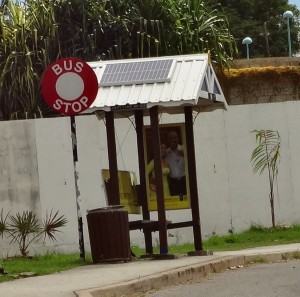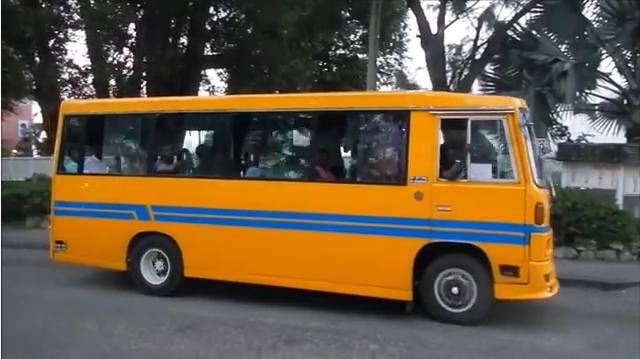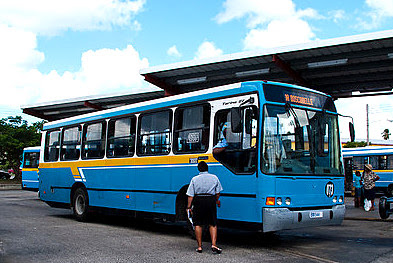BY ANGELA HOWARD
Barbados
Living in a country less than one third the size of the city of Los Angeles would make you think it would be easy to get around. But while there are many busses on the island, as a foreigner, they can be quite challenging to navigate. So here it is folks, “The Foreigner’s Guide to Understanding Bajan Buses!”

Hold on tight, you’re in for a treat! Most buses in Barbados have rails and handles bolted to the walls and seats for people to hang on. You’ll want to hang on even while sitting down, trust me! Buses in Barbados can feel like roller coasters without seatbelts.
Keep in mind that in Barbados people drive on the left side of the rode and the driver’s side is right. There have been many times in low traffic areas where I have waited for a bus on the wrong side of the road.
Most busses in Barbados do not have set time schedules. It would just put more stress on everyone if they did, because they would never be on time. Rather than leaving at a certain time, they leave once they have reached max (or close to max) capacity. If you get to a bus terminal and are directed to hop on an empty bus, you might be waiting for quite a while. There are three main types of busses in Barbados: ZRs (pronounced Zed-Rs), Minibuses, and Blue buses. Please note that all buses charge the same fare regardless of distance: $2 Barbados.
ZR
ZRs, also known as music busses, are modified 14 passenger vans owned by a private company.

The original seats have usually been taken out, and new ones are brought in to maximize seating. I’ve traveled in ZRs with over 30 people packed into one. The “mate” who collects the money from passengers is a master of human Tetris. They always seem to find new innovative ways to cram more people inside to maximize profits. (There was even an event at UWI Sports Day called “Pack a ZR!”) These buses are well known for blasting Bajan music, zooming down roads at racing speeds, and stopping wherever people ask (as compared to at bus stops) even though getting off a bus anywhere other than a bus stop is illegal. They can be identified as white vans with a maroon stripe. The ZRs usually take shorter routes along the South and West Coasts are more commonly seen driving through residential neighborhoods. Usually there is a doorbell to press to signal to the ZR driver that you want to disembark. The horns that these buses use sound like squeaky brakes! While I would not recommend the ZRs if you are severely claustrophobic or prone to motion sickness, I think that they are a blast and everyone visiting Barbados should experience them!
Pros:
- A true Bajan experience
- Pick up and drop off anywhere (do not need to wait at a bus stop)
- Often able to provide change for up to $50 Barbados if you do not have small change for bus fare
- Accept $1 US as fare payment
Cons:
- Common to sit on a stranger’s laps to maximize space
- Do not have posted schedules or routes
- Can be very claustrophobic
- Predominantly travel on the south and west coasts
 Minibus
Minibus
Next we have the Minibuses which can be identified as being yellow. I’ve been on quite a variety of Minibuses. Some are nicer than Californian public busses, and others are completely falling apart. You never know what you’re going to get until you get on the bus. While these busses run the occasional secluded route, I most frequently see them traveling from Bridgetown (the capital of Barbados also known as B-Town) in the south to Speightstown (SP-Town) in the north. While the Minibuses often accept bills larger than $2 Bajan, they do not always, so it is a good idea to try and have exact change when getting on these buses. Unlike the ZRs, the Minibuses do in fact pick up and drop off people predominantly at bus stops. Particularly during rush hour these buses get very full but seldom decline entry to new passengers. While locals are accustomed to this, I have seen tourists have panic attacks due to the capacity of the bus. Finally, in order to get on these buses you must gesture to the bus driver to stop by holding your arm out at a bus stop. If you simply wait at a bus stop and do not flag the bus down, they will not stop for you. In order to get off these buses, there are usually doorbells on the sides of the bus; however, sometimes you must press a lump in a black strip that lines the ceiling. (I assure you, that will make much more sense if you are on the bus!)
Pros:
- Larger than ZRs
- Frequently run along the west coast (sometimes three will pass by within a five-minute period)
- Accept $1 US as fare payment
Cons:
- Very full during rush hour
- Do not always have change for bills larger than $2 Barbados
- Do not have posted schedules or routes
- Predominantly travel on the south and west coasts
Blue Buses

Finally, on the bus front we have the blue government operated buses. These buses require exact change. If the smallest bill you have is $5 Barbados, then you are going to be out $3 after paying for bus fare. However, these buses do have an online posted schedule. That being said, I have never seen them run on time. The blue busses travel all over the island, whereas the Minibuses and ZRs are more heavily concentrated on the south and west coasts. In order to get off these buses, you usually have to pull a black string attached to the ceiling. If you press the red “stop” buttons, nothing happens (as I learned the hard way) and the bus will not drop you off at your intended destination.
Pros:
- Travel all over the island
- Posted online schedules and routes
Cons:
- Must have exact change
- Do not accept US dollars as payment
- Only pick up/drop off at bus stops
Rather than buses having flashing neon signs with destinations like Californian buses, most Bajan buses have a laminated sheet of paper on the front windshield that states the bus’s final destination. The ZRs also have numbers on the back that indicate a certain route. If you’re ever unsure if your intended stop is on the route, simply ask the driver. They are very friendly. Very few minibuses and ZRs run on Sundays, as it is seen as a day of rest.
Unfortunately Google Maps has not been programed to handle the Barbados public transit system due to unset schedules and constant changing routes. If you’re ever in doubt, just ask a local, they are always eager to lend a helping hand!
Angela Howard studied abroad in Cave Hill, Barbados, in Spring 2017: http://eap.ucop.edu/OurPrograms/barbados/Pages/univ_west_indies.aspx



